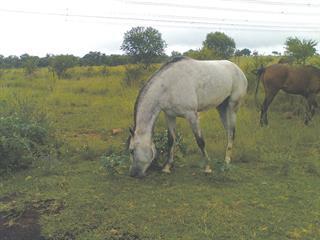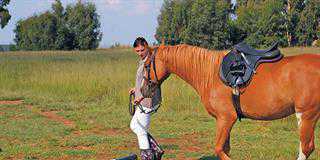
With all the heavy rain this season, more than grass is growing in the paddocks where horses graze. From a distance the green may look like good feed, but up close some of the weeds between the grass can be potentially lethal for horses.
Datura species (both D. ferox and D. stramonium) have been implicated in fatal impaction colic in horses in South Africa.
This plant, also called stinkweed or kasteroliebos, grows on old lands or alongside kraals or horse paddocks where there’s a lot of nitrogen in the soil due to fertilisation or dung.
Plants grow to over 1m high and have thick stems with large, hairless green leaves and trumpet-shaped white or mauve flowers. The tiny black seeds are scattered when the large, spiny seedpod dries and bursts open.
Horses usually don’t eat the green plant unless there is no other grazing, because of the bitter smell. People who have accidently picked the small plants when harvesting marog (African spinach) have shown severe symptoms just from touching the juice. However, when dry the plants don’t have the same sharp smell and are particularly dangerous if the leaves and stems are incorporated when tef is baled.
Often the seed pods are accidentally harvested with maize or sunflowers and only burst as they dry. The tiny black seeds are particularly poisonous and a very small dose mixed with dried maize kernels or horse rations can cause impaction colic in horses.
Symptoms of ingestion
The plant contains high levels of the alkaloids atropine, hyoscine and hyoscyamine, which inhibit the movement of smooth muscles in the intestines and the secretion of saliva. A typical symptom is the enlargement of the pupil. In horses this dilation of the pupils makes the eye very sensitive to light and can cause them to panic.
The alkaloids also cause hallucinations and may contribute to the wild behaviour of poisoned horses. The heart rate and respiration are increased and the mucous membranes of the mouth are dry and sticky to the touch. The rectal temperature is normal or decreased.
Impaction colic means that the horse becomes constipated. The horse strains and kicks at its stomach. Faeces build up in the large intestine and may even cause rupture. The horse stops eating and often shows nervous signs with trembling of the muscles. If the dose is large, the horse will eventually convulse. On post-mortem, the tiny kidney-shaped Datura seeds are often found throughout the digestive tract.
Treatment and recovery
Treatment is very difficult. There is no antidote. The vet can give supportive treatment with fluids and may use enemas to try and wash out the impacted ingesta rectally. After hospitalisation a stomach tube may be stitched into place and repeated lavage (stomach washes) done to try and remove plant material. Recovery is slow and affected horses may need nursing for three to seven days.
It’s important to remove the plants as soon as possible. They can be cut when partly grown, but the person doing so should be very careful to prevent the juice spraying into their eyes or mouth. After good rains, before the seeds form, it’s easy to pull the plants out, but use thick rubber gloves.
Removed plants should be burned as they often set seed after being pulled out.
The dried plants are also toxic and livestock are more likely to eat them. When buying baled tef or eragrostis hay, check it for the presence of weeds. The Datura seeds are also fairly obvious among the lighter coloured tef or eragrostis seeds that fall out as bales are moved.













